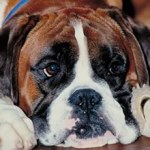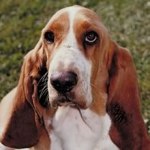Anjing Chinese Shar-Pei
Chinese Shar-Pei Description
Both heavily wrinkled dogs with large heads and smaller headed dogs with tighter looking skins occur in this breed. There are three coat varieties: horse-coat and brush-coat and a rare bear-coat, which is not recognized by the AKC. The bear-coat, does not falling within AKC standard because this particular Shar-Pei has an undercoat and a topcoat exceeding 1 inch. The popular theory about the bear-coat is that it’s a “throwback” to the chow-chow. They are actually quite popular as pet quality Shar-Pei, albeit rare, and often confused with the chow by unknowing owners as well as animal shelter workers. The unusual horse-coat is rough to the touch, extremely prickly and off-standing. The brush-coated variety has longer hair and a smoother feel. The coat on either variety can be up to one inch in length. Coat colors include all solid colors and sables. There is also a lowered, spotted, and a parti colored Shar-Pei coat, which is a disqualifying fault in the show ring according to AKC standard. The small ears fall forward and the tail is carried in a curl. Like the Chow Chow, these dogs have a blue-black tongue. It has a square profile with a broad, full head and wide, padded muzzle. Puppies have more wrinkles than adults. Shar-Pei slowly loose their wrinkles as they get older.
Chinese Shar-Pei Temperament
The Shar-Pei is very loyal to his handler. It is an intelligent dog that does not always follow orders slavishly. Playful, active, dominant, and brave. They bond with their family, but are not unfriendly toward strangers. If the dog meets cats and children while it is still young, it usually will not have a problem with them. The Chinese Shar-Pei has a frowning expression, but is surprisingly easy-going, calm, independent, and devoted. They make a delightful companion and good watchdogs. The Shar-Pei needs a confident handler. If you are too uncertain, too inconstant, too soft, or too mild in the dog’s eyes, it will take over as the boss. Shar-Pei need firm, but gentle and extremely consistent training. They are stubborn and bold and need firm obedience training to establish your leadership. They may refuse commands from family members who have not established leadership over them. They need an owner who as the ability to be “Top Dog”. These dogs are very clean and almost housebreak themselves. Shar-Pei generally hate water and try as hard as they can to avoid it. Puppies grow very quickly and must be fed accordingly. Mixing other dogs can sometimes be a problem and socialization is important. However some Shar-Pei are less dominant then others and show lines tend to be less dog-aggressive, mixing well with other dogs. Some Shar-Pei tend to slobber, especially when in pain. It is important to find a reputable breeder when seeking a Shar-Pei. This breed was very popular in the 1980’s. It was referred to as one of the “Yuppie Puppies”, meaning the breeds that were carelessly over-bred. A lot of this breeds personality and health depends on the lines it comes from. Good Shar-Pei lines will get along well with other dogs and will not have skin problems, which is a hereditary condition.
Chinese Shar-Pei Height, Weight
Height: 18-20 inches (46-51 cm.)
Weight: 40-55 pounds (18-25 kg)
Chinese Shar-Pei Health Problems
Fevers of unknown origin or swollen hocks syndrome may be the early stages of amolydosis (kidney failure). One misconception is that the Shar-Pei have skin problems due to their wrinkles. Yes some Shar-Pei have skin problems, but it is not because the dog has wrinkles, but rather a hereditary condition. Due to over popularity in the 1980’s, some Shar-Pei do have hereditary skin problems. However if you buy from a reputable breeder, this conditions will not be a problem. Be sure to find a breeder who strives for healthy dogs.
Chinese Shar-Pei Living Conditions
The Chinese Shar-Pei will do okay in an apartment if it is sufficiently exercised. It is moderately active indoors and will do okay without a yard. Because of their padded head, the Shar-Pei is very sensitive to heat. Shade and water must always be available. Provided they get enough exercise, they will be very peaceful indoors.
Chinese Shar-Pei Exercise
The Chinese Shar-Pei have a considerable need for exercise, which include a daily walk. Do not over exercise them in the heat, as they are sensitive to it.
Chinese Shar-Pei Life Expectancy
Up to 10 years.
Chinese Shar-Pei Grooming
The Shar-Pei should be brushed regularly. Their coat is never trimmed. This breed does not have an undercoat. The “bush” coat sheds a little year round, but the “horse” coat tends to shed only during molting periods. Molting may leave the dog looking unkempt. Bathing about once a week and brushing the coat daily during this period will remove the old dead hair and allow the new coat to grow in. Some owners are allergic to the harsh coat.
Chinese Shar-Pei Origin
The ancestry of the Shar-Pei is uncertain. It may be a descendant of the Chow Chow, however, the only clear link between these are the purple tongue. However, pictures on pottery suggest the breed was present even in the Han Dynasty (206bc). For many years the Shar-Pei was kept as a general-purpose farm dog in the Chinese countryside, used for hunting, protecting stock, and guarding the home and family. During that time the Shar-Pei was breed for intelligence, strength and scowling face. Later, it was used in dog fighting. The loose skin and extremely prickly coat were developed to aid the dog in fighting, making the Shar-Pei difficult for the opponent to grab and hold on to. During the Communist Revolution, dogs were rescued by a Hong Kong business man named Matgo Law, who appealed to Americans in 1973 though a dog magazine to save the breed. From those few specimens, the Shar-Pei fancy has grown tremendously over the past decades. Now the Shar-Pei is in the Non-Sporting Group of the AKC with over 70,000 dogs registered as foundation stock. When first introduced, Shar-Pei were astronomically expensive. Now they cost about the same as any other purebred dog.









